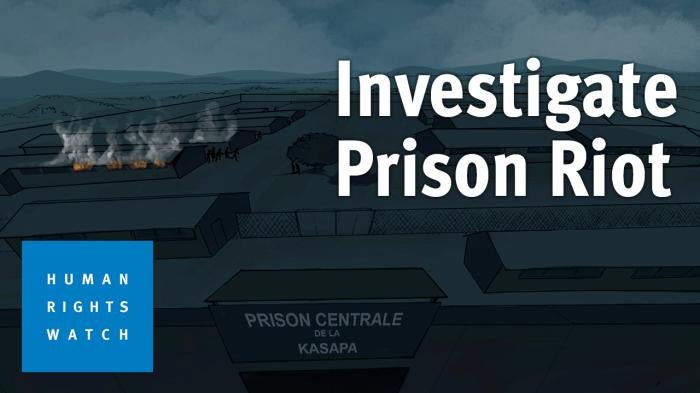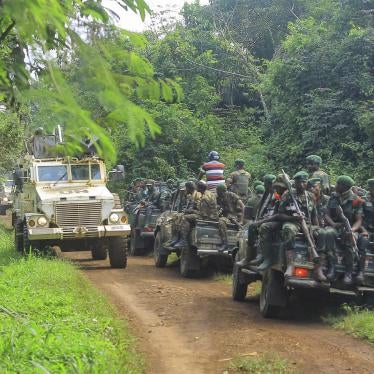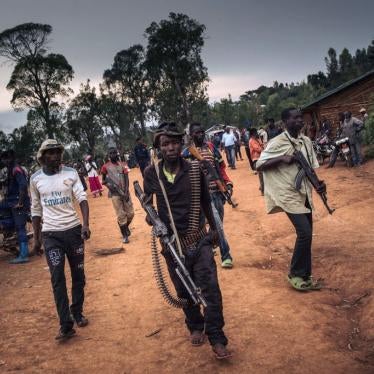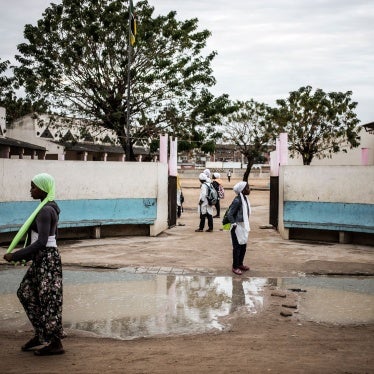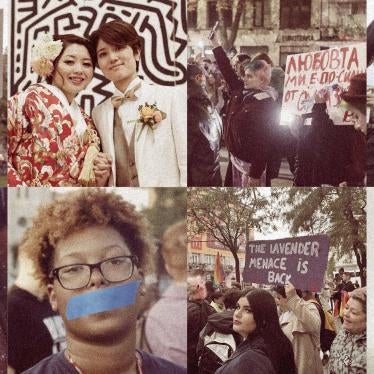(Kinshasa) – Democratic Republic of Congo authorities have made no apparent progress investigating the September 2020 prison riot at Kasapa Central Prison in Lubumbashi, Human Rights Watch said. For three days, inmates repeatedly raped several dozen female detainees, including a teenage girl.
The authorities should provide survivors with adequate medical care and mental health support. They should credibly and impartially investigate the incident, including officials who ignored repeated warnings of the impending riot, and fairly prosecute those responsible for abuses.
“Congolese authorities should meaningfully investigate and act on the three days of rampage and mass rape at Kasapa prison to punish those responsible and prevent further breakdowns of the prison system,” said Thomas Fessy, senior Congo researcher at Human Rights Watch. “Almost a year on, rape survivors are still awaiting adequate medical care and help as they face trauma and stigma.”
The riot started on September 25, when a group of 15 inmates deemed dangerous and held separately from the others overpowered their only guard and stormed through the prison. They incited other prisoners to violence, set several buildings on fire, and rapidly took over the prison while staff, guards, and security forces fled the prison.
A fire in the women’s section forced the female detainees into the main prison yard for three days without protection, shelter, food, water, or safe access to toilet facilities. Male inmates burned all the women’s belongings and imposed a climate of fear. “For fear of being raped, we wouldn’t even go wash ourselves,” said a female survivor, 38.
On September 28 a group of prisoners handed over more than 40 inmates – including those who allegedly led the unrest – to security forces, who then reentered the prison. Although the provincial police chief urged the authorities to empty Kasapa prison, which by then was in ruins, only about 200 prisoners out of a total of about 2,000 were subsequently transferred to other prisons.
From December 2020 to April 2021 Human Rights Watch interviewed 42 people, including 14 female survivors of the unrest, as well as male inmates, medical and aid workers, local activists, prison and judicial staff, and United Nations staff in Lubumbashi and Kinshasa, the capital. Human Rights Watch conducted field research at Kasapa prison in March.
Human Rights Watch reviewed an internal UN report that found that security forces shot and killed at least 20 inmates, including at least 7 who may have been extrajudicially executed while they were trying to escape through a dugout tunnel. One prison guard also died from injuries sustained during the riot.
Four August 2020 letters signed by prison officials and addressed to provincial authorities warned about insecurity in the prison and requested the transfer of a group of “very dangerous inmates.” Prison officials said that the letters went unanswered. Warnings of an imminent plot involving the same group were also ignored five days before the riot and again just hours before it started, prison officials said.
Of the 56 female detainees in the prison, 37 women and a teenage girl testified to Lubumbashi’s public prosecutor that male inmates had raped them. Human Rights Watch interviewed 13 of the detainees who said they had been sexually assaulted or raped. Prison staff, UN officials, and local human rights activists told Human Rights Watch that the majority of female inmates, and possibly all, were raped but some of them did not report the rapes to the prosecutor for fear of the stigma associated with sexual assault. There were also credible reports of rape of six men and boys.
Some survivors said they were gang raped or were raped several times by different men during the three days of unrest. They said that the women who resisted were often beaten or hit with sharp tools and weapons. “Three young men came toward me with machetes and knives … and took me behind the block, threatening to cut my head off if I resisted,” said a 37-year-old detainee. “All three of them came on top of me, and when I tried to resist, one hit me with a machete, injuring me above my eye.”
Several sources described an attack in which numerous inmates raped a woman visiting a prisoner the day the riot started, and penetrated her with sharp objects. Interviewees said that two other female visitors and a female police officer were raped. During the unrest there were also violent clashes between rival groups of inmates over the prison’s informal control system.
Medical statistics from the unrest viewed by Human Rights Watch stated that at least seven detainees, including a 16-year-old girl, became pregnant, most likely as a result of being raped during the unrest. A number had newly contracted HIV/AIDS and other sexually transmitted infections.
After the riot, the authorities failed to provide survivors with timely and adequate post-rape care, such as medical care for physical injuries, emergency contraception against pregnancy, HIV post-exposure prophylaxis and medication to prevent other sexually transmitted infections, as well as counseling support, Human Rights Watch said. Despite alerts from local activists, provincial authorities did not send a medical team to Kasapa prison to attend to sexual violence survivors until December 1, two days after Radio France Internationale (RFI) reported on the rapes.
A nongovernmental group provided some post-rape care on September 30, but beyond the 72-hour required window, and due to the lack of stock, only half of the women detainees benefited from it. Others were only given antibiotics. For at least two weeks after the riot, all the female detainees slept in the open, in one of the prison churches whose roof had collapsed during the fire.
Between December 2 and 16, the humanitarian organization Médecins Sans Frontières (Doctors Without Borders, MSF) set up a temporary clinic inside the prison to treat rape survivors. The Haut-Katanga provincial governor, Jacques Kyabula, confirmed in a letter to Human Rights Watch that an investigation into the rapes was ongoing. He did not respond to inquiries about the unheeded warnings or the factors that led to the three-day riot at the prison.
“The failure to meaningfully investigate the Kasapa prison riot is emblematic of the government’s longstanding neglect of Congolese prisons and the people held in them,” Fessy said. “Congo’s government needs to adopt measures to uphold the dignity and security of the inmates and ensure that everyone, particularly women and girls, is protected from sexual violence.”
Kasapa Central Prison
Kasapa Central Prison, built in 1958, has a capacity of 800 inmates. At the time of the riot, the prison’s population was nearly 2,000, including 56 women and 53 children, according to prison authorities. As many as 81 percent of all inmates were still in pretrial detention and among the women, only five had been convicted. Contrary to both Congolese and international human rights law, Kasapa prison houses inmates from both civilian and military jurisdictions, and it mixes detainees awaiting trial with convicted prisoners.
Poor hygiene and sanitation, inadequate food supplies and health care, overcrowding, weak security, violence, and a lack of gender-sensitive rehabilitation services, including sexual and reproductive health for women, mirror prison conditions across the country.
Under international law, government authorities have a duty of care for people in prisons, including an obligation to protect their rights to life, health, safety, and security. The African Commission on Human and Peoples’ Rights in its 1995 Resolution on Prisons in Africa, calls on African countries to conform to the “international norms and standards for the protection of the human rights of prisoners.” The UN Standard Minimum Rules for the Treatment of Prisoners (the Mandela Rules) state that prisoners are to be treated with dignity and have prompt access to medical attention, and that women be held in entirely separate premises. Under the UN Bangkok Rules for the treatment of women prisoners, governments also have an obligation to ensure services that respond to the particular needs of women and children, including gender-specific healthcare services at least equivalent to those available in the community. The African Commission on Human and Peoples’ Rights and the International Covenant on Civil and Political Rights obligate governments to investigate and appropriately punish those responsible for abuses against people in custody, including sexual and gender-based violence, and provide reparations for victims.
Unheeded Warnings
Human Rights Watch found that provincial military and civilian authorities had been repeatedly warned about insecurity and the threat posed by certain inmates at Kasapa Central Prison. Sources both inside and outside the prison said that tensions had been simmering for months with rival gangs of prisoners engaged in a power struggle. Security and order in the prison rely on a “kapita” system, in which prison authorities informally cede to prisoners some administrative and disciplinary powers. The head kapita is generally supported by two deputies. Rivalries for control escalated throughout 2020.
In letters on August 4, 19, and 25, the penitentiary inspector commanding Kasapa’s military section alerted senior military magistrates and penitentiary officials in both Lubumbashi and Kinshasa about ongoing “security instability” within the prison. He requested the transfer of “11 very dangerous inmates” to a high-security detention center to address the problem. The prisoners, who had been convicted for criminal conspiracy, illegal possession of weapons of war, and insurrection, were “trying to escape at all costs,” the August 25 letter read.
On August 29 the prison director, Pelar Ilunga, wrote to the provincial interior minister, the provincial governor, and military and judicial authorities, insisting on the need to transfer dangerous detainees for security reasons.
None of the four letters were answered. Officials at Kasapa prison are not authorized to initiate prison transfers.
Ilunga confirmed that on September 21, other prisoners informed him that a group of convicts were planning to escape. He said that he alerted the provincial interior minister via text messages. On September 25 the same group was caught plotting a prison break that included burning mattresses and stealing weapons from police guards, a prison clerk said. Ilunga placed the 15 prisoners in a separate confinement cell, adding that he passed this information to provincial authorities. The group included the 11 mentioned in the August 25 letter, according to the inspector commanding Kasapa’s military section.
The Riot
On September 25 at about 4 p.m., the 15 prisoners who had been placed in a disciplinary cell just hours earlier, overpowered their sole guard and escaped. As they stormed through the prison, more inmates joined them as they stole field tools such as machetes, spades, and hoes from a storage facility to use as weapons. Rioters then set the administration building on fire, looted the clinic and a food depot, and burned both structures as well.
Amid the chaos, guards, who are unarmed, fled the premises while some prison staff were trapped in offices.
The military section commander entered the prison around 5 p.m. with armed police. They rescued trapped prison staff, including the commander’s deputy who had been severely beaten and later died from his injuries, and female guards who were hiding in the women’s quarters.
Prisoners confirmed that security forces used teargas to force inmates back into their cellblock but were unable to keep them inside. Inmates retaliated, burning more sections of the prison.
Ilunga arrived on site around 6 p.m., shortly after the police and military reinforcements. The kapita and his deputies were taken to safety outside the prison and, being prisoners themselves, were held in a cell at the prosecutor’s office in Lubumbashi until order was restored at the prison. At least two women detainees told Human Rights Watch that they had begged the prison director to take them to safety outside the prison, but that he and the security force personnel refused. “We were crying but [the prison director] said he couldn’t take us out of the prison because some women were convicted for murder,” one woman said. Ilunga told Human Rights Watch that he did not have the logistical means to evacuate the women’s section.
As the unrest grew in intensity, security forces and prison officials turned off power and shut the prison gates behind them, effectively leaving inmates in control of the prison.
Three days later, on September 28, a group of prisoners eventually put down the unrest and took control. They detained at least 40 inmates, including those who allegedly led the riot, tied them up, and handed them over to security forces.
On October 7 the Haut-Katanga province police chief, Gen. Louis Segond Karawa, said that Kasapa prison should be entirely emptied because it did not meet any security standards following the violent events. Karawa said:
We have nearly 60 women inmates [at Kasapa] and juveniles who are vulnerable; one sees what happens if we leave them among all these men and criminals. I demand that we transfer everyone [somewhere else] while we see how to rebuild this prison because in its current state, we can’t even refurbish it.
In the two weeks that followed the uprising, about 200 inmates were transferred to Likasi’s Buluo prison. On October 15, five convicted women were transferred to Boma prison, also in Likasi. Fifty soldiers have since been assigned to securing Kasapa prisons outside perimeter.
Sexual Violence
Over the course of three days, female detainees were repeatedly raped, sometimes by several male inmates taking turns, and at least one woman was penetrated with objects. Once the female prison section had been set on fire, the female detainees called for help to escape. Shortly after, the rapes began and continued while the female detainees slept in the prison yard.
Ruth, 28, who like all survivors quoted is identified by a pseudonym to protect her safety, said that several men raped her on the first and second nights of the riot: “It was around 11 p.m. each time. There were so many of them that I can’t tell you the exact number. They rushed over me, each of them wanted to take their turn.”
Inmates carrying sticks and knives would choose women detainees in the yard and rape them either on the spot or in a more isolated corner. Amina, 38, said: “I went to urinate in the gutter when men came up to me and grabbed me by force. There were many of them, with machetes, iron bars, and knives … They had me walk to the back garden and raped me there.”
Francine, 34, was carrying her newborn baby on her back and taking care of her three-year-old daughter when prisoners assaulted her and two other women. “It was on the first night; three men came for my daughter, but I protected her,” she said. “They took me instead, with two other women; my baby fell off my back and they raped the three of us. They told us not to look at them or they would hit us.”
Some women said that more than 10 inmates raped them on the first night. Thirty survivors told MSF that they were raped by five, ten, or up to twenty inmates. If a woman resisted, the men would call others to come and rape them to punish them, according to a UN report.
In some cases, male inmates forced women to strip naked and protest in front of the prison gates to demand the release of prisoners.
Human Rights Watch received credible reports of up to six cases of prisoners raping male inmates but could not speak directly with any male survivors. At least six teenage boys, ages 14 to 17, may have also been raped by male inmates, according to the UN, but Human Rights Watch could not corroborate the allegations.
Physical and Psychological Trauma
Women detainees said that staying on prison grounds where they had endured sexual violence forced them to constantly relive their horrific ordeal. Several survivors reported symptoms consistent with post-traumatic stress, including nightmares, insomnia, and persistent feelings of fear.
Ruth described her symptoms:
I have nightmares here and I can hardly sleep. I have insomnia and I have a constant pain in my stomach. We have to get out of here. How can they leave us here after all that has happened? I was in good health when I first arrived in prison. Who is going to take responsibility for what happened to me? We haven’t had good care, and we don’t even get medicine anymore. We need to see doctors and get good treatment.
Bibiche, 43, whose husband is also held at Kasapa prison, said inmates groped her multiple times and punched her in the stomach. She said she was still suffering from abdominal pain at the time Human Rights Watch interviewed her in March 2021.
In his June 23 letter to Human Rights Watch, Kyabula, the provincial governor, said that the provincial government “responds regularly and promptly to the requests of needs from [Kasapa prison’s] director and the medical center’s chief doctor.” However, rape survivors did not receive timely and adequate medical care. A local nongovernmental organization provided emergency care to some of the women detainees on September 30, 2020, five days after the first rape cases, making post-rape treatments ineffective to prevent HIV infection and unwanted pregnancy. Moreover, only half of the women benefited from the treatment due to lack of stock; others were only given antibiotics.
Provincial authorities did not provide the prison with basic first aid kits and medication before late October, multiple sources said. Survivors of sexual violence received no medical treatment or counseling for two months, until a medical team was eventually deployed on December 1. The next day, MSF set up a medical tent on the prison grounds, treated all women and provided them with psychological support until December 16. Authorities have not provided any follow-up medical or psychosocial support to the rape survivors since that date. Human Rights Watch is not aware of any medical assistance provided to male survivors of sexual violence.
Bernadette, 30, said she was raped twice during the riot. She had an unplanned pregnancy as a result but miscarried. She was released from prison in late February 2021 and described her continuing physical pain: “When I wash, my body tingles and I have vertigo. I contracted diseases and infections because of the rape and the conditions in prison. I still have abdominal pain since I’ve been freed but I can’t afford an ultrasound.”
Stigma and Rejection
Stigma and rejection are significant barriers for women and girls from Kasapa Central Prison in disclosing rape or seeking help. Some survivors said they fear their husbands or partners would abandon them if they disclosed they had been raped. Others said they feared family members would blame them, or that community members would publicly taunt them.
Micheline said she lied to her husband:
A group of four boys came up to me, they took me behind the storage facility. I was crying, begging them to let me go. I told them they could have been my children, [three] then stopped but one of them still raped me. When my husband asked me what they had done to me, I lied to him and told him that they beat me. I can’t tell him that I was raped, otherwise my marriage will end.
Henriette, 47, said her husband stopped visiting her after he found out she was raped. She explained that his church eventually convinced him to visit her, but he warned that she would need to pay a “fine” to return home once released according to his customs.
One of the detainees who was freed in recent months, Josephine, 54, said she was not able to tell her husband that she was raped and had contracted HIV:
If I tell my husband that I was raped and I got HIV, he will kick me out, and where am I going to go? I will be in the streets. I can’t even tell my children … My life is now wasted, my marriage and the future of my children, too.
Absence of Justice
On September 29, 2020, Lubumbashi’s public prosecutor opened an investigation into the rapes. Thirty-seven women detainees and a 17-year-old girl testified during the public prosecutor’s investigation that they had been raped.
In an October 5 letter that Human Rights Watch has seen, the prosecutor requested a medical examination of sexual violence survivors by one of Lubumbashi’s main hospitals. However, despite this request and a second one in late November, hospital authorities failed to comply. Human Rights Watch contacted the hospital’s director by phone in April, but the director would not answer questions.
Between October and December, investigators interviewed 38 female detainees at Kasapa prison. In January 2021, investigators went to Likasi and interviewed three convicted women who had been transferred to Boma prison. They also interviewed four of the alleged riot leaders who had been transferred to Buluo prison. On June 23, investigators returned to Buluo prison to interview ten prisoners alleged to have committed rape, and confronted them with three survivors. Investigators say they lack logistical support to plan a new round of interviews.
The military prosecutor interviewed all prison officials, according to Kasapa’s military section commander. However, Human Rights Watch has found no evidence that any investigation was taking place into the security failings that enabled the September riot to occur.
